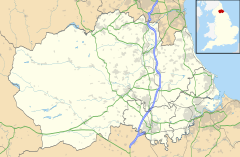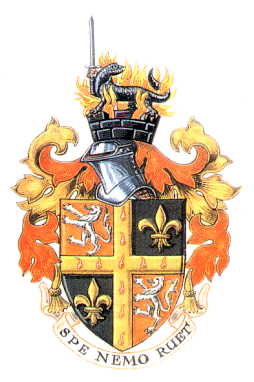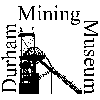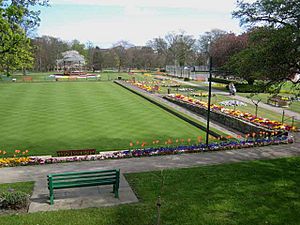Spennymoor facts for kids
Quick facts for kids Spennymoor |
|
|---|---|
| Town and civil parish | |
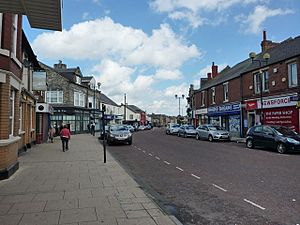 Cheapside |
|
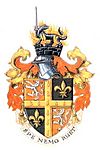 The town council arms Motto: SPE NEMO RUET "With hope, no one shall fail" |
|
| Population | 19,816 (2011 Census) |
| OS grid reference | NZ261340 |
| Civil parish |
|
| Unitary authority |
|
| Ceremonial county | |
| Region | |
| Country | England |
| Sovereign state | United Kingdom |
| Post town | SPENNYMOOR |
| Postcode district | DL16 |
| Dialling code | 01388 |
| Police | Durham |
| Fire | County Durham and Darlington |
| Ambulance | North East |
| EU Parliament | North East England |
| UK Parliament |
|
Spennymoor is a town in County Durham, England. It is located south of the River Wear. The town is about 7 miles (11 km) south of Durham. Spennymoor also includes the nearby villages of Kirk Merrington, Middlestone Moor, Byers Green, and Tudhoe. In 2011, about 19,816 people lived in the area.
Contents
Spennymoor's Past: A Journey Through Time
Early Beginnings: From Moorland to Town
The area where Spennymoor stands today was once a huge open moor. It was covered with thorny bushes. The name "Spennymoor" might come from "spina," a Latin word for thorn. "Mor" was an old Anglo-Saxon word for moor. Another idea is that it comes from a Scandinavian word meaning "shingle-hut."
Long ago, the Romans built a camp nearby at Binchester. This camp was called Vinovium. It was a strong fort on a hill above the River Wear. Many old Roman coins, pots, and altars have been found there. Later, Binchester became part of the lands of the Earl of Northumberland.
The moor itself was not used much in early times. But it was connected to nearby villages like Kirk Merrington and Tudhoe. These villages shared rights to use the moor. Over time, the moor became the property of Merrington Priory.
Today, Merrington church is a well-known landmark. It was first built by the Normans. In 1143, a Scottish leader fortified it. The church was rebuilt in 1850 but kept its original Norman style.
Times of Trouble and Change
After the Norman Conquest, William the Conqueror's soldiers caused much destruction. This area became a wild place for outlaws and animals.
In 1346, a big battle happened near Durham. The Scottish army, led by David of Scotland, was in the area. England's Queen Phillipa led an army of 16,000 soldiers north. They met the Scots at Neville's Cross. The English won a great victory. During the battle, monks from Durham prayed for England. They held up a special cloth from the Cathedral.
In 1420, much of the land, including Whitworth and Tudhoe, became property of the Neville family. The Earl of Westmorland started the Whitworth park we see today.
In 1615, a large group of men gathered on the moor. They were learning military skills. Many of these men were miners. Coal pits were already being worked nearby. Later, in 1677, the moorland was divided among local landowners. Only a small part was left for a water spring.
The Rise of Industry in Spennymoor
Before 1800, the moor was mostly empty. Roads were few and dangerous. Horse races were held on the moor. Miners and their families would come to watch.
Modern Spennymoor grew because of mining. The first pit, Wittered, opened in 1839. Simple houses were built for the miners. Coal from Merrington Colliery started coming up in 1841.
In 1853, a large ironworks opened at Tudhoe. This brought many workers to the area. More houses were built. Workers also came from Wales and Lancashire when new mines opened. In the 1860s, better houses were built at Tudhoe Grange. These were different from the usual crowded rows of houses.
The 1800s also saw growth in education and religion. A school opened in 1841. St. Paul's Church was built in 1858. Miners earned good wages in the 1860s and 1870s. Spennymoor became busy with collieries and ironworks. Better houses were built, and Co-operative stores opened. A railway line opened in 1876, connecting Spennymoor to other towns.
However, good times were followed by harder ones. By 1879, wages for miners and ironworkers dropped. In 1882, a terrible explosion at Tudhoe Colliery killed 37 people. A long strike in 1892 caused problems. But it also led to new machines at the Tudhoe Iron works. This factory then had the largest mill in Europe.
Entering the 20th Century
In 1894, Spennymoor gained some self-government. The new council faced a big challenge: poor housing. Many homes were crowded and lacked proper facilities. Reports from the time described very difficult living conditions. Even in 1920, few houses had indoor toilets.
The early 1900s also brought a long period of economic difficulty. The ironworks closed in 1901. The Dean and Chapter colliery opened in 1904, helping with jobs. But the town relied heavily on coal mining. Many collieries closed before and after the big coal strike of 1926. Unemployment was very high, over 33% by 1938.
Brighter Days and New Growth
Despite job problems, housing began to improve in the 1930s. The council started building new homes. By 1935, 66 council houses were built. More houses followed, helping to clear some of the worst areas.
World War II brought changes. Housing slowed down, but industry grew. A Royal Ordnance Factory opened in 1941. This factory provided many jobs outside of coal mining. After the war, industrial activity decreased, but not as severely as before. The decline of the mining industry was still a big challenge.
On Christmas Eve 1944, a German V-1 flying bomb hit Tudhoe's cricket ground. It was aimed at Manchester but landed in Spennymoor. This was the furthest north a V-1 bomb landed during World War II.
In 1963, plans were made for Spennymoor to become a "growth point." This meant redeveloping the town center. The old ironworks site was cleaned up. New roads were planned. Industrial estates were expanded. New industries began to arrive. Factories like Electrolux, Thorn Lighting, and Black and Decker opened.
Housing also improved greatly after the war. By 1963, many old houses were removed. Over 1,120 new council houses were built. Private housing developments also started. The biggest project was turning the old Tudhoe ironworks site into the Bessemer Park Housing Estate. Work began in 1968 on over 1,000 new homes.
In the 1970s, Spennymoor was home to the famous 'Top Hat' nightclub. It was a popular place for music and dancing. Many famous bands played there, including Hot Chocolate, Van McCoy, and KC and the Sunshine Band.
Getting Around Spennymoor
Spennymoor railway station opened in 1845. It closed on March 31, 1952.
Today, buses serve Spennymoor. Route 6 runs between Durham and Bishop Auckland three times an hour. The X21 bus goes between Newcastle and Bishop Auckland twice an hour.
Spennymoor in the News
Local news and TV shows come from BBC North East and Cumbria and ITV Tyne Tees. Radio stations include BBC Radio Newcastle and Capital North East. The town also has local newspapers like The Northern Echo.
Well-Known People from Spennymoor
- John Bain, known as TotalBiscuit, was a video game commentator. He lived and went to school in Spennymoor.
- Gibson Gowland, an actor, was born in the town.
- Anne Wood, who created the Teletubbies and In The Night Garden, grew up in Spennymoor.
- Chloe Castro is a singer and songwriter.
- Norman Cornish was a famous mining artist. He lived in the town and his art was inspired by it.
- George Courtney is a well-known football referee.
Cool Places to See in Spennymoor
Whitworth Hall
Whitworth Hall dates back to 1183. The Shafto family owned it for over 300 years. This included "Bonnie Bobby Shafto", who is famous from a well-known song. Today, it is the Whitworth Hall Hotel. It still has a deer park and a beautiful walled garden.
Spennymoor Settlement
This is a local arts community. It was started in the 1930s by Bill and Betty Farrell. Its goal was to help people learn and be creative together. The Settlement had the town's first library. Famous people like artist Norman Cornish and writer Sid Chaplin were part of its history. Today, it is a center for drama, music, and other community events.
Durham Mining Museum
The Durham Mining Museum is located in Spennymoor Town Hall. It tells the story of mining in northern England. The museum has small mining tools and models of big machines. Visitors can also experience a pretend mine tunnel. It opened in 1998 and is dedicated to the memory of over 24,000 people who died in mining accidents in the North of England.
Miners' Banner
A new miners' banner was first marched in 2006. This was at the Durham Miners' Gala, also called The Big Meeting. The banner represents 13 old local coal mines. It was shown the night before the event. On the day of the march, it visited "The Tubs." This is a memorial made from old mining carts. It honors all the men and boys who died in the mines of Spennymoor. The banner also visited two war memorials.
Fun Things to Do and Sports
A main attraction in Spennymoor is Victoria Jubilee Park. Queen Victoria gave this park to the town. It was to celebrate her reign. The land was once part of the Whitworth Hall estate. A special arch was built in the park for the new millennium.
The leisure center has a swimming pool. It offers swimming lessons, football coaching, and martial arts. You can also find fitness classes and a gym there. It is home to a modern Regional Gymnasium Centre. This center was built with money from the National Lottery.
Spennymoor Town F.C. is the local football team. They won the FA Vase in 2013. They beat Tunbridge Wells F.C. 2–1 in the final at Wembley Stadium.


